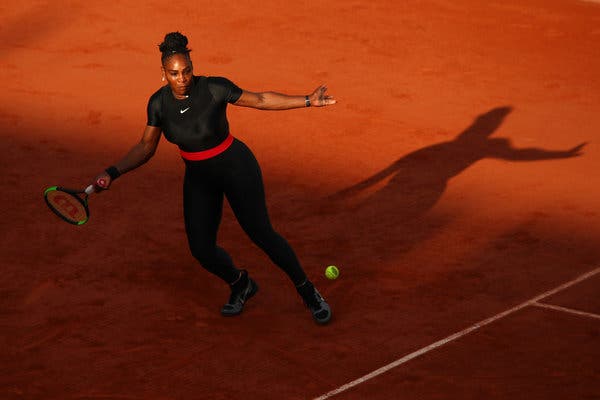For most of the history of women’s tennis, the “dress” — once upon a time a long skirt, now more of a wisp of an idea — has symbolized the feminine side of the game in its most retrograde sense, and been used as a means of gender stereotype, self-expression, and eyeball-attracting marketing. It has flirted with the tropes of fashion-as-decoration, and fashion as an extension of a personal brand, but only within well-behaved bounds.
Finally, however, in the hands of Serena Williams, it has become a political tool: an unabashed statement of female empowerment and independence not just for herself, but for all. It has been happening slowly over the last year, but it crystallized this week with the French Open, which began on Sunday.
That’s where Ms. Williams unveiled her latest Nike outfit — or Nike x Off White outfit (designed by Virgil Abloh, the multi-hyphenate founder of Off-White as well as the artistic director of Louis Vuitton men’s wear). Which was a black-and-white striped crop top, tennis skirt, trapeze-back jacket that flew out like a cape in the wind, and maxi skirt (for photos), all emblazoned with the French words for “Mother, Champion, Queen, Goddess.”
People have gotten very excited about it in the court of social media, as might be expected.
But while this is all to a certain extent a statement about Ms. Williams and her talent, what’s really interesting is that it’s also a statement about women in general. (In case anyone doubted that was where this was all going.) And to what extent they should be free to break old rules that have lost all meaning.
It began this time last year, when Ms. Williams appeared at the French Open in a catsuit. She said it was to help prevent blood clots after what had been a difficult birth and recovery and also it made her feel like a superhero (a legitimate connection, though why superheroes always wear catsuits is another question). The French Open authorities, however, saw it a different way — dress code violation! — and controversy ensued.

Ms. Williams playing against Julia Georges during the 2018 French Open.CreditClive Brunskill/Getty Images
The Gallic powers that be looked hidebound and prissy; public opinion applauded her (duh!) and suddenly the whole idea of what should and should not be worn on the court and who should get to decide, a subject of debate since Andre Agassi threw his first neon-colored tantrum in the 1990s, was back in the news. Only this time the subject was women’s bodies, and this time the world had changed.
Whether Ms. Williams had planned it or not, she became the sharp end of the spear aimed at the artifact that was the women’s tennis rule book. And though she never said it exactly, she played the point with her usual expertise, and has chosen the mantle that now rests on her shoulders.
At the U.S. Open that August Ms. Williams appeared in a tennis tutu (also designed by Mr. Abloh for Nike). A dress that on its own was taken as something of a riposte to the French — you want girlie, I can do girlie — but which sent a message about reclaiming and reinventing old tropes of what was considered traditionally “ladylike” and defining them as powerfully as she pleased.
And then, in January, Ms. Williams showed up at the Australian Open in a short unitard, liberated from the idea of a skirt altogether. Which brings us back to the French Open.
“I love when fashion becomes a vehicle for sharing a powerful message,” Ms. Williams said in a statement when the style was first released. In recent years, for many players that message had been individual, and kind of corporate. She’s making it universal, and using it, perhaps, to carve a new off-court future for herself.
Earlier this month she stood at the top of the steps of the Metropolitan Museum of Art in a long Versace gown (with sneakers, natch) as one of the co-hosts of the Costume Institute Gala. She understands as well as anyone on the court — or in sport, for that matter — what fashion can do. She learned long ago, along with her sister, that people were going to pay attention to what players wore.
Now it’s a means to further an agenda — one that goes beyond winning another tournament or breaking another record. One that, increasingly, she wears very well.









